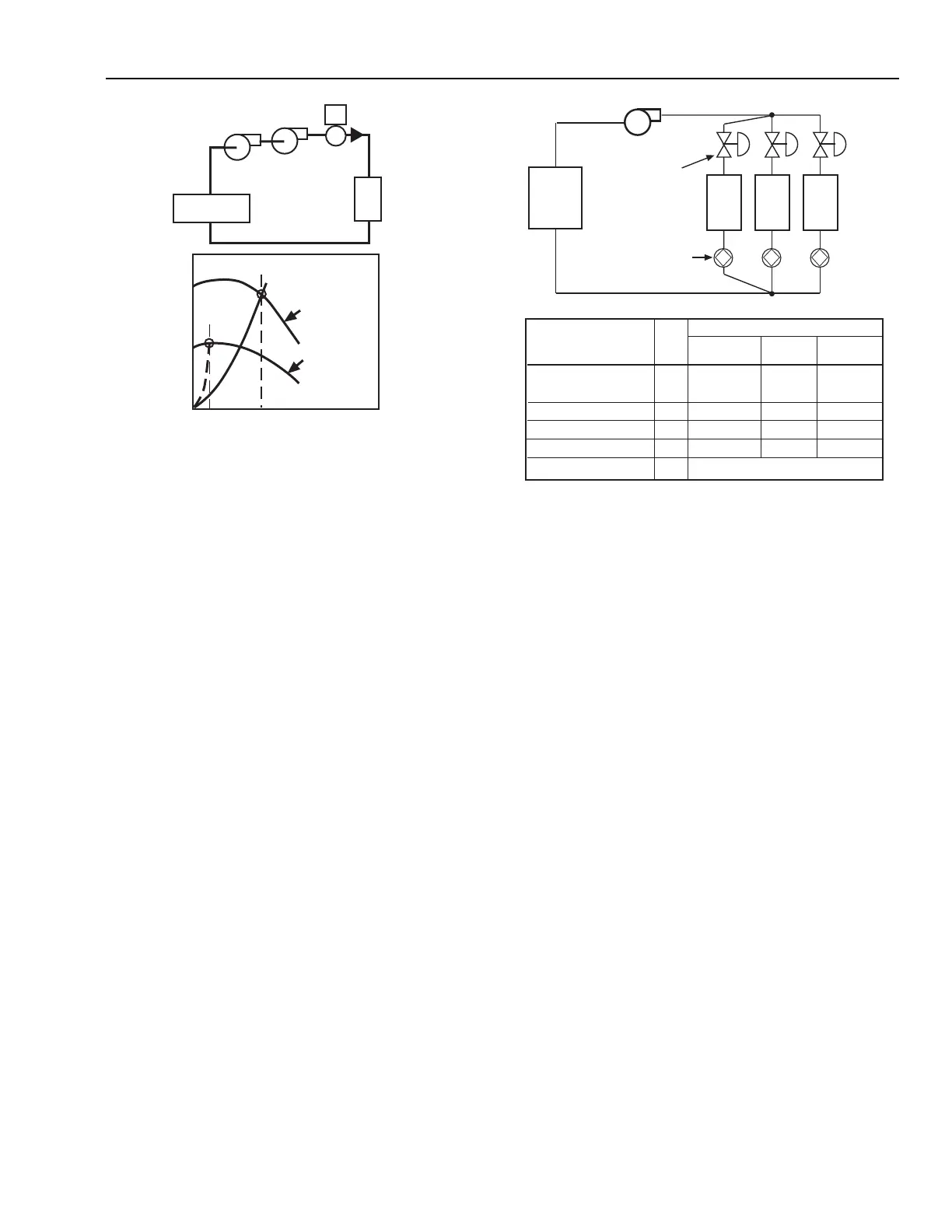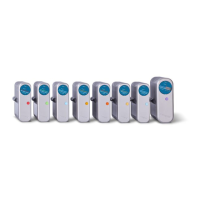ENGINEERING MANUAL OF AUTOMATIC CONTROL
CHILLER, BOILER, AND DISTRIBUTION SYSTEM CONTROL APPLICATIONS
345
Fig. 67. System Operation for Series Pumps.
Dual Pump Curves
For pumps in parallel (Fig. 66), assuming two identical
pumps, the curve is developed using the following formula:
flow
3
=(flow
1
) x 2 for any p
1
Where:
flow
3
= Total flow for both pumps
flow
1
= flow of one pump
p
1
= Pressure in kPa for Pump 1 at flow
1
for any
point on pump curve
For pumps in series (Fig. 67), assuming two identical pumps,
the curve is developed using the following formula:
p
3
=(p
1
) x 2 for any flow
1
Where:
p
1
= Total pressure in kPa for both pumps
p
1
= Pressure in kPa for one pump at flow
1
(for
any point on Pump 1 curve)
DISTRIBUTION SYSTEM FUNDAMENTALS
Figure 68 illustrates a closed system where static pressure
(pressure within the system with pump off) does not need to be
considered as long as all components are rated for the static
pressure encountered. The pump provides force to overcome
the pressure drop through the system and valves control the
flow and pressure through the system. Figure 69 shows a graph
of the system and pump curves for design load and reduced
load conditions. The system curve indicates the pressure drop
through the system (with the control valves full open) at various
flow rates. The pump curve shows the pump output pressure at
various flow rates. Flow always follows the pump curve.
SERIES
PUMPS
CONTROL
VALVE(S)
LOAD
2 PUMPS
1 PUMP
24%
LOAD
FULL
LOAD
FLOW
HEAT
EXCHANGER
HEAD
C2410
Fig. 68. Simplified Water Distribution System.
In Figure 68 the flow and pressure considerations are:
1. The flow through the heating or cooling source, the supply
piping, and the return piping (2.5 L/s) is the same as the
sum of the flows through the three coil circuits:
0.6 + 0.8 + 1.1 = 2.5 L/s.
2. Design pressure drop includes the drop through the
heating or cooling source, supply piping, return piping,
and the highest of the three coil circuits:
69 + (30 + 33) = 132 kPa.
NOTE: In this example, Coil 1 and 3 balancing valves
balance each load loop at the 63 kPa design
for Loop 2. If the actual coil and control valve
drops were less than the design maximum
values, the actual balancing valve effects
would be greater.
In this example the pump must handle 2.5 L/s against a total
pressure of 132 kPa as shown in Figure 69. (This curve is taken
from actual pump tests). The design drop across the valve is
33 kPa with the valve fully open.
If Figure 68 is a heating system, as the loads reduce valves
V1, V2, and V3 start to close. Hot water flow must be reduced
to about 15 percent of full flow (0.375 L/s) to reduce heat output
to 50 percent. As flow through the coil is reduced the water
takes longer to pass through the coil and, therefore, gives up
more heat to the air.
HEATING/
COOLING
SOURCE
1
V1
2
V2
3
V3
HEATING
OR
COOLING
COILS
PUMP
SUPPLY PIPING
RETURN PIPING
CONTROL
VALVES
BALANCING
VALVES
C4603
* SUM OF SOURCE AND PIPING (69 kPa) AND COIL LOOP 2 (63 kPa) = 132 kPa
DESIGN PRESSURE DROP IN kPa
FLOW
IN
L/s
COIL & PIPING
CONTROL
VALVE
BALANCING
VALVE
ITEM
2.5
69* _ _
HEATING OR COOLING
SOURCE AND
DISTRIBUTION PIPING
COIL 1 LOOP
COIL 2 LOOP
COIL 3 LOOP
TOTAL FLOW AND DROP
0.6 24 33 6
0.8 30* 33* 0*
1.1 21 33 9
2.5 132*

